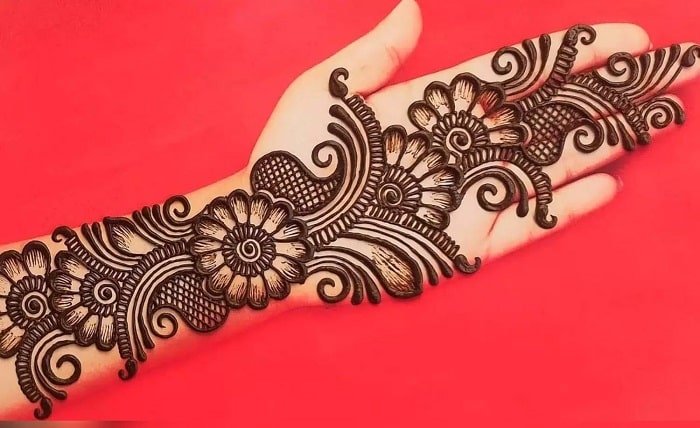Trending Mehandi Ki Design Ideas for Every Occasion: Latest Styles You’ll Love

Mehandi ki design refers to the intricate and artistic henna patterns applied on hands and feet, commonly in South Asian and Middle Eastern cultures. These designs are traditionally used during weddings, religious festivals like Karva Chauth, Eid, and Diwali, and other joyous events. The significance of mehandi ki design lies not just in its beauty but also in its cultural and spiritual symbolism.
In modern times, mehandi ki design has evolved into an art form, with endless variations and creativity. Whether it’s simple Arabic lines or complex bridal styles, the demand for elegant mehandi ki design patterns continues to grow, transcending borders and styles.
Types of Mehandi Ki Design You Should Know About
There are several unique types of mehandi ki design styles that cater to different preferences and occasions. The most popular one is the Arabic mehandi ki design, known for its bold lines and spaces. Then there’s the Indian traditional style, which often includes motifs like peacocks, mango leaves, dulha-dulhan figures, and temple elements.
Another widely adored mehandi ki design is the Pakistani style, which combines intricate patterns with bold layouts. For those who prefer a minimalistic look, the Moroccan or Indo-Western designs offer a trendy twist while still honoring the tradition of mehandi ki design.
Latest Bridal Mehandi Ki Design Trends for 2025
Bridal mehandi ki design has seen a major glow-up in recent years. Brides are opting for highly personalized designs that tell a story — like their love story, proposal moment, or even wedding date hidden in the henna! These mehandi ki design patterns typically cover both arms up to the elbows and the feet till mid-calf, adorned with paisleys, mandalas, and miniature portraits.
Modern brides are also blending traditional mehandi ki design with contemporary flair — think glitter, colored henna, and even 3D effects. The bridal trend is all about making the mehandi ki design as unique as the bride herself.
Simple Mehandi Ki Design Ideas for Beginners
Not everyone wants an elaborate mehandi ki design, especially when you’re just learning or applying it yourself. For beginners, simple floral mehandi ki design, trail patterns, or finger-tip designs are great starting points. These require less time, and you can still flaunt your creativity.
Many people begin with a basic mehandi ki design that consists of dots, leaves, semi-circles, and lines. These easy designs still look beautiful and can be enhanced with practice. Whether you’re prepping for a small puja or just love body art, a simple mehandi ki design works for all.
Mehandi Ki Design for Kids: Cute and Fun Patterns
Kids love the feel and look of mehandi ki design, especially during festive seasons or family weddings. However, applying intricate designs on little hands isn’t practical. Instead, cute butterfly designs, cartoon motifs, and flower-based mehandi ki design are ideal for children.
Using cones that are made from natural henna and safe ingredients is essential for kids. The key is to keep the mehandi ki design light and fun while still looking adorable. Whether it’s a small heart on the back of the hand or a smiley face, kids’ mehandi ki design is all about creativity and comfort.
Feet Mehandi Ki Design: Beautify Your Ankles and Toes
While most people focus on hand patterns, mehandi ki design for feet holds equal charm and significance, especially in bridal functions. Paisley and mandala patterns near the ankle, netted motifs around the toes, and floral vines running up the legs are some trending foot mehandi ki design options.
The elegance of mehandi ki design on feet enhances the overall look, particularly when paired with anklets and toe rings. For brides and dancers, a well-crafted foot mehandi ki design completes the ethnic vibe and adds a graceful touch to every step they take.
Tips to Make Your Mehandi Ki Design Dark and Long-Lasting
A common question people ask is: How can I make my mehandi ki design darker and long-lasting? Here are a few proven tips:
-
Always clean your skin before applying mehandi ki design to remove oils and lotions.
-
Once the mehandi ki design is applied, let it dry for at least 4–6 hours (overnight is best).
-
After drying, dab a mixture of lemon juice and sugar over your mehandi ki design to enhance color.
-
Avoid washing the mehandi ki design with water for the first 24 hours.
-
Lastly, keep your hands warm — heat helps in releasing the dye from the henna.
By following these steps, your mehandi ki design will stay vibrant and deep for days, making you stand out in every celebration.
Conclusion
In a world where traditions meet trends, mehandi ki design continues to hold a special place in every celebration. From bridal moments to festive nights, these intricate patterns enhance beauty and express cultural richness. Whether you love bold Arabic strokes or delicate Indian art, there’s a mehandi ki design for every mood, skill level, and occasion.
So go ahead, try out a new mehandi ki design today and feel the joy of adorning your hands and feet with timeless beauty!
FAQs
1. Which is the best mehandi ki design for weddings?
For weddings, bridal mehandi ki design with full-arm coverage, motifs like peacocks, dulhan-dulha, and paisleys are ideal.
2. How long does a mehandi ki design last?
A typical mehandi ki design lasts 1–3 weeks, depending on skin type, care routine, and the henna quality used.
3. Can I do my own mehandi ki design at home?
Yes! With a little practice and online tutorials, you can easily try mehandi ki design at home, especially simple and Arabic styles.
4. Is mehandi ki design safe for kids?
Yes, as long as you’re using natural henna without chemicals. Stick to fun and minimal mehandi ki design patterns for kids.
5. What are trending mehandi ki design patterns in 2025?
In 2025, trending mehandi ki design styles include personalized bridal motifs, minimal geometric patterns, and colored/glitter henna.